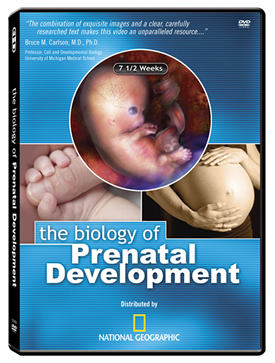Multilingual Illustrated DVD [Tutorial]
The Biology of Prenatal Development
出生前發育生物學
中文 (繁體) [Mandarin (Traditional)]
Download English PDF Download Spanish PDF Download French PDF What is PDF?
Table of Contents
- THE EMBRYONIC PERIOD (THE FIRST 8 WEEKS)
-
- EMBRYONIC DEVELOPMENT: THE FIRST 4 WEEKS
-
- Chapter 3 – Fertilization
- Chapter 4 – DNA, Cell Division, and Early Pregnancy Factor (EPF)
- Chapter 5 – Early Stages (Morula and Blastocyst) and Stem Cells
- Chapter 6 – 1 to 1 1/2 Weeks: Implantation and Human Chorionic Gonadotropin (hCG)
- Chapter 7 – The Placenta and Umbilical Cord
- Chapter 8 – Nutrition and Protection
- Chapter 9 – 2 to 4 Weeks: Germ Layers and Organ Formation
- Chapter 10 – 3 to 4 Weeks: The Folding of the Embryo
- EMBRYONIC DEVELOPMENT: 4 TO 6 WEEKS
-
- Chapter 11 – 4 Weeks: Amniotic Fluid
- Chapter 12 – The Heart in Action
- Chapter 13 – Brain Growth
- Chapter 14 – Limb Buds and Skin
- Chapter 15 – 5 Weeks: Cerebral Hemispheres
- Chapter 16 – Major Airways
- Chapter 17 – Liver and Kidneys
- Chapter 18 – Yolk Sac and Germ Cells
- Chapter 19 – Hand Plates and Cartilage
- EMBRYONIC DEVELOPMENT: 6 TO 8 WEEKS
-
- Chapter 20 – 6 Weeks: Motion and Sensation
- Chapter 21 – The External Ear and Blood Cell Formation
- Chapter 22 – The Diaphragm and Intestines
- Chapter 23 – Hand Plates and Brainwaves
- Chapter 24 – Nipple Formation
- Chapter 25 – Limb Development
- Chapter 26 – 7 Weeks: Hiccups and Startle Response
- Chapter 27 – The Maturing Heart
- Chapter 28 – Ovaries and Eyes
- Chapter 29 – Fingers and Toes
- THE 8-WEEK EMBRYO
- THE FETAL PERIOD (8 WEEKS THROUGH BIRTH)
-
- Chapter 37 – 9 Weeks: Swallows, Sighs, and Stretches
- Chapter 38 – 10 Weeks: Rolls Eyes and Yawns, Fingernails & Fingerprints
- Chapter 39 – 11 Weeks: Absorbs Glucose and Water
- Chapter 40 – 3 to 4 Months (12 to 16 Weeks): Taste Buds, Jaw Motion, Rooting Reflex, Quickening
- Chapter 41 – 4 to 5 Months (16 to 20 Weeks): Stress Response, Vernix Caseosa, Circadian Rhythms
- Chapter 42 – 5 to 6 Months (20 to 24 Weeks): Responds to Sound; Hair and Skin; Age of Viability
- Chapter 43 – 6 to 7 Months (24 to 28 Weeks): Blink-Startle; Pupils Respond to Light; Smell and Taste
- Chapter 44 – 7 to 8 Months (28 to 32 Weeks): Sound Discrimination, Behavioral States
- Chapter 45 – 8 to 9 Months (32 to 36 Weeks): Alveoli Formation, Firm Grasp, Taste Preferences
- Chapter 46 – 9 Months to Birth (36 Weeks through Birth)
The Fetal Period (8 Weeks through Birth)
Chapter 37 9 Weeks: Swallows, Sighs, and Stretches
胎兒期繼續,直到出生。
到9週, 開始吸拇指,
胎兒可以咽羊水。
胎兒也可以抓住物體、
把頭向前或者向後移動、
開、合顎、移動舌頭、
嘆氣和伸展。
面部、雙手的手掌 以及雙腳腳底 的神經感受器能夠 感覺輕微接觸。
"作為對腳底輕微接觸的反應", 胎兒會彎曲髖和膝蓋, 可能彎曲腳趾。
面部、雙手的手掌 以及雙腳腳底 的神經感受器能夠 感覺輕微接觸。
"作為對腳底輕微接觸的反應", 胎兒會彎曲髖和膝蓋, 可能彎曲腳趾。
現在眼瞼完全閉上。
在喉嚨中, 聲韌帶的出現
標示聲帶發育的開始。
女性胎兒中, 可以辨認子宮,
叫做卵原細胞的
不成熟生殖細胞
在卵巢中復制。
外部生殖器開始 自己分辨男女。
外部生殖器開始 自己分辨男女。
Chapter 38 10 Weeks: Rolls Eyes and Yawns, Fingernails & Fingerprints
9至10週之間的急劇生長
使體重增加超過75%。
到10週,對上眼瞼的刺激
導致眼睛往下翻。
胎兒打哈欠, 經常打開和關閉嘴巴。
胎兒打哈欠, 經常打開和關閉嘴巴。
大多數胎兒 吸右手大拇指。
臍帶內的腸子部份 回到腹腔。
臍帶內的腸子部份 回到腹腔。
大多數骨骼正在骨化。
手指甲和腳指甲開始發育。
受精後10週出現獨特的指紋。
這些指紋在一生中
可以用來鑒別身份。
Chapter 39 11 Weeks: Absorbs Glucose and Water
到11週,
鼻子和嘴唇完全形成。
與身體其它部份一樣,
在人類生活周期中, 它們的外貌
每個階段會改變。
腸子開始吸收胎兒咽下的
葡萄糖和水。
雖然受精時 便確定了性別,
現在才能
從外部生殖器 辨別男女。
Chapter 40 3 to 4 Months (12 to 16 Weeks): Taste Buds, Jaw Motion, Rooting Reflex, Quickening
在11至12週之間,
胎兒體重增加將近60%。
十二週標示懷孕的 第一個三分之一, 即三個月的結束。
十二週標示懷孕的 第一個三分之一, 即三個月的結束。
獨特的味覺芽現在
覆蓋在嘴巴里面。
在出生之前, 味覺芽只是
保留在舌頭和嘴巴 的上顎上。
大便於12週開始,
持續大約6週。
首次從胎兒和新生兒 的結腸排出的物質 叫做胎糞。 它含有 消化道流下的 消化酶、蛋白質 和死細胞。
首次從胎兒和新生兒 的結腸排出的物質 叫做胎糞。 它含有 消化道流下的 消化酶、蛋白質 和死細胞。
到12週, 上肢長度
幾乎達到與身體
的最後比例。
下肢需要較長時間
才能到達最後比例。
除了背部和頭頂之外,
胎兒的全部身體現在
對輕微接觸作出反應。
以性別決定對發育差別
首次出現。
例如,女性胎兒
比男性胎兒表現出
更頻繁的顎運動。
與前面的收回反應 形成對照,
在嘴巴附近的刺激 現在引起
轉向刺激物 和嘴巴張開。
這種反應叫做 "覓食反射",
出生後繼續保持,
在喂奶過程中 幫助新生兒找到
母親的奶頭。
脂肪堆積物
開始填滿頰, 牙齒發育開始,
面部繼續成熟。
到15週,血液形成的
幹細胞到來,
在骨髓裏繁殖。
大多數血細胞 在這類形成。
雖然6週胚胎開始運動,
孕婦在14至18週之間
首次感到胎兒運動。
傳統上把這個事件
叫做胎動初覺。
Chapter 41 4 to 5 Months (16 to 20 Weeks): Stress Response, Vernix Caseosa, Circadian Rhythms
到16週,把針插入 胎兒腹部,
該程序引起
荷爾蒙 逼迫反應,
向血流中釋放
去甲腎上腺素 或降腎上腺素。
在呼吸系統,
支氣管樹現在 幾乎完整。
一種叫做胎兒皮脂的
保護性白色物質
現在覆蓋著胎兒。
胎兒皮脂保護皮膚 不受羊水的
刺激影響。
從19週起,胎兒運動、 呼吸活動
和心搏率以一日為周期,
叫做晝夜節律。
Chapter 42 5 to 6 Months (20 to 24 Weeks): Responds to Sound; Hair and Skin; Age of Viability
到20週,在完全
發育的內耳裏,
聽覺器官耳蝸
已經達到成年人 的尺寸。
從現在開始,
胎兒對各種 聲音作出反應。
頭皮上開始生長頭髮。
所有皮膚層和結構出現, 包括毛囊和腺。
所有皮膚層和結構出現, 包括毛囊和腺。
到受精後的21至22週
肺臟獲得一些 呼吸空氣的能力。
這被視為 生存能力時期
因為一些胎兒可能 在子宮外生存。
Chapter 43 6 to 7 Months (24 to 28 Weeks): Blink-Startle; Pupils Respond to Light; Smell and Taste
到24週, 眼瞼重新打開,
胎兒顯出 眨眼吃驚反應。
女性胎兒這種對 突然的大聲音
的反應發育得較早。
幾個調查人員報告, 大聲音可能對
胎兒健康有 不良影響。
直接後果 包括延長的、 增加的心搏率、
過多胎兒吞咽 和突然行為改變。
可能的長期後果 包括聽力損失。
胎兒的呼吸率 可以提高到
每分鐘吸入-呼出44次。
在懷孕的第三個三個月,
頭腦的快速生長 消耗胎兒使用能量
的50%以上。
頭腦重量增加 400%到500%。
到26週, 眼睛生產眼淚。
在27週,瞳孔對光作出反應。 這種反應在一生中 控制到達 視網膜的光量。
在27週,瞳孔對光作出反應。 這種反應在一生中 控制到達 視網膜的光量。
嗅覺機能運作
所需要的全部成份 都在運作。
對早產嬰兒的研究
揭示受精後26週
覺察氣味的能力。
在羊水中放入甜的物質 增加胎兒的吞咽率。 相反,加入苦的物質 減少胎兒的吞咽率。 通常還有面部表情的變化。
在羊水中放入甜的物質 增加胎兒的吞咽率。 相反,加入苦的物質 減少胎兒的吞咽率。 通常還有面部表情的變化。
通過一系列類似步行的
步伐運動, 胎兒翻筋頭。
皮下形成更多 脂肪堆積物,
胎兒沒有那麼多皺了。
出生後,脂肪對
保持體溫和存儲能量 作用重大。
Chapter 44 7 to 8 Months (28 to 32 Weeks): Sound Discrimination, Behavioral States
到28週,胎兒能夠分辨
高音和低音。
到30週,呼吸活動 更為普遍,
一般胎兒30%到40% 的時間呼吸。
在懷孕的最後4個月,
胎兒顯示同等活動期,
中間插有休息期。
這些行為狀態
反應中樞神經系統
不斷變化的複雜性。
Chapter 45 8 to 9 Months (32 to 36 Weeks): Alveoli Formation, Firm Grasp, Taste Preferences
到大約32週,
真正氣泡,
即"口袋"細胞
開始在肺臟發育。
它們繼續形成, 直到8週歲。
在35週,胎兒手抓得緊。
胎兒對各種物質的接觸
看來影響出生後的 香味偏愛。
例如,胎兒的母親吃了茴香
這種乾草味的物質,
胎兒出生後顯示
對茴香的偏愛。
沒有接觸過茴香的
新生兒不喜歡茴香。
Chapter 46 9 Months to Birth (36 Weeks through Birth)
胎兒釋放大量
一種叫做雌激素的
荷爾蒙,開始分娩,
由此開始胎兒向 新生兒的轉變。
子宮有力收縮標示分娩, 導致生產。
子宮有力收縮標示分娩, 導致生產。
從受精到出生以至以後,
人類發育動態、 持續和複雜。
關於這個迷人過程的新發現
愈加顯示胎兒發育
對畢生健康 的重大影響。
我們對早期人類發育的 理解在進展, 我們提高健康的能力也是如此 - 包括出生之前和之後。
我們對早期人類發育的 理解在進展, 我們提高健康的能力也是如此 - 包括出生之前和之後。


